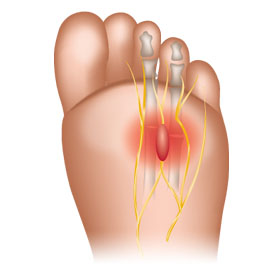Neuromas
 A neuroma is a thickening of nerve tissue that may develop in various parts of the body. The most common neuroma in the foot is a Morton’s neuroma, which occurs between the third and fourth toes. It is sometimes referred to as an intermetatarsal neuroma. “Intermetatarsal” describes its location in the ball of the foot between the metatarsal bones. Neuromas may also occur in other locations in the foot.
A neuroma is a thickening of nerve tissue that may develop in various parts of the body. The most common neuroma in the foot is a Morton’s neuroma, which occurs between the third and fourth toes. It is sometimes referred to as an intermetatarsal neuroma. “Intermetatarsal” describes its location in the ball of the foot between the metatarsal bones. Neuromas may also occur in other locations in the foot.
The thickening, or enlargement, of the nerve that defines a neuroma is the result of compression and irritation of the nerve. This compression creates enlargement of the nerve, eventually leading to permanent nerve damage.
Symptoms
If you have a Morton’s neuroma, you may have one or more of these symptoms where the nerve damage is occurring:
- Tingling, burning, or numbness
- Pain
- A feeling that something is inside the ball of the foot
- A feeling that there’s something in the shoe or a sock is bunched up
- The progression of a Morton’s neuroma often follows this pattern:
- The symptoms begin gradually. At first they occur only occasionally, when wearing narrow-toed shoes or performing certain aggravating activities.
- The symptoms may go away temporarily by removing the shoe, massaging the foot, or by avoiding aggravating shoes or activities.
- Over time the symptoms progressively worsen and may persist for several days or weeks.
- The symptoms become more intense as the neuroma enlarges and the temporary changes in the nerve become permanent.
Diagnosis
To arrive at a diagnosis, your podiatrist will obtain a thorough history of your symptoms and examine your foot. During the physical examination, the doctor attempts to reproduce your symptoms by manipulating your foot. Other tests or imaging studies may be performed. The best time to see your podiatrist is early in the development of symptoms. Early diagnosis of a Morton’s neuroma greatly lessens the need for more invasive treatments and may avoid surgery.
When Is Surgery Needed?
Surgery may be considered in patients who have not responded adequately to non-surgical treatments. Your podiatrist will determine the approach that is best for your condition.
